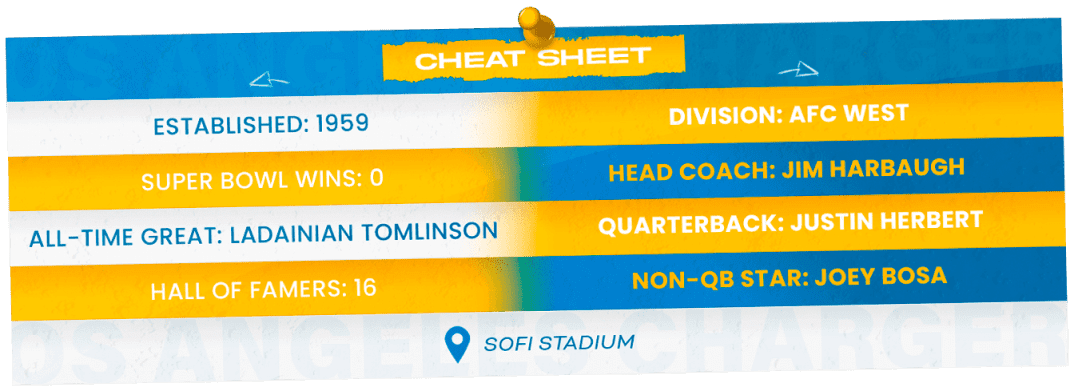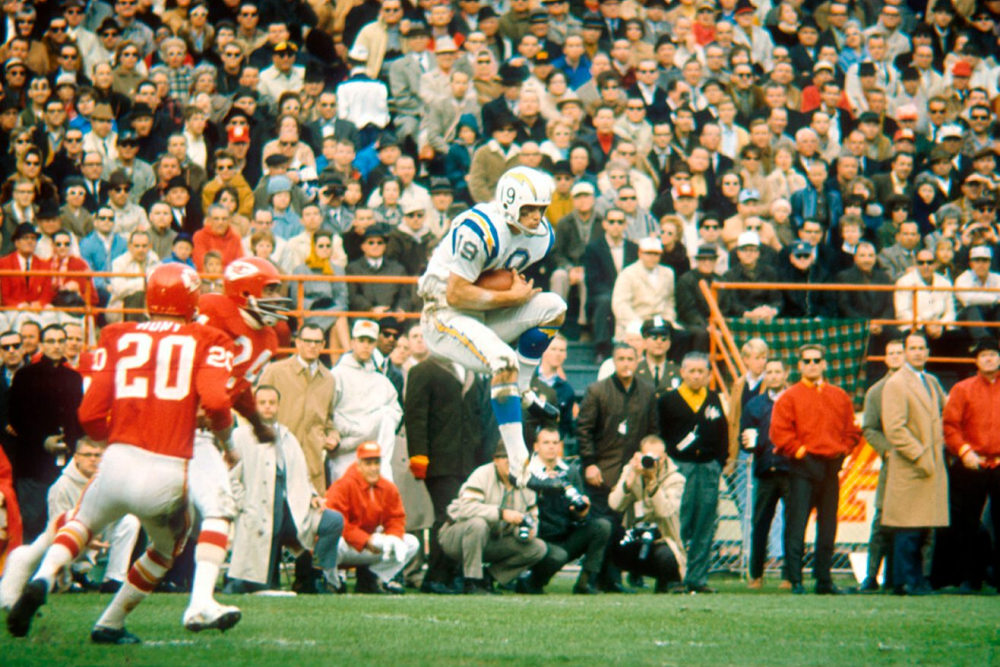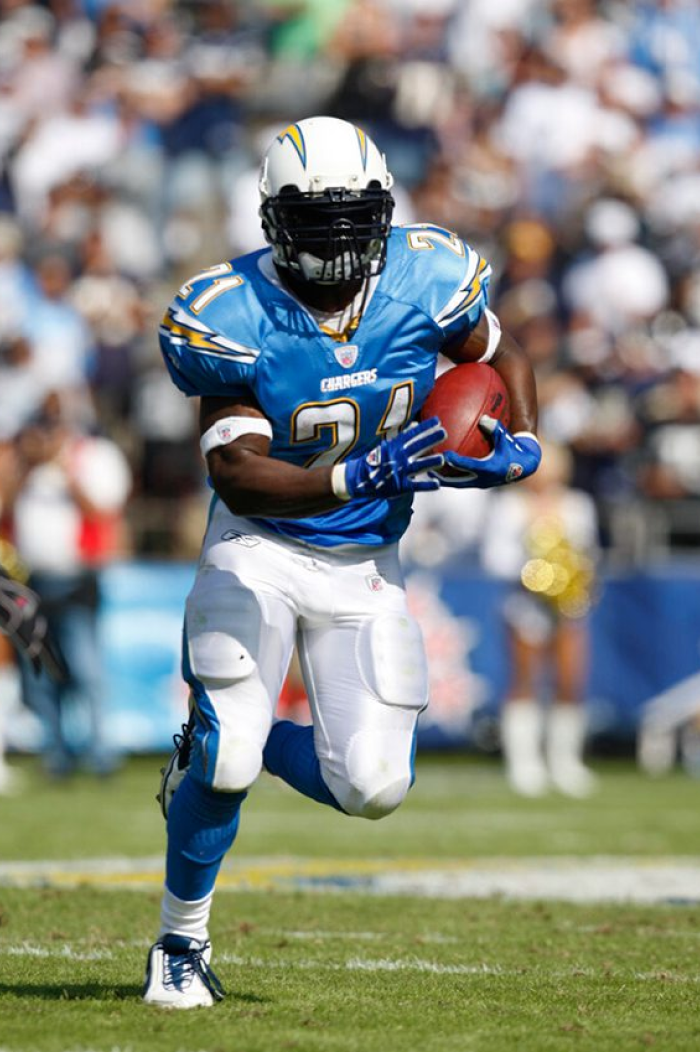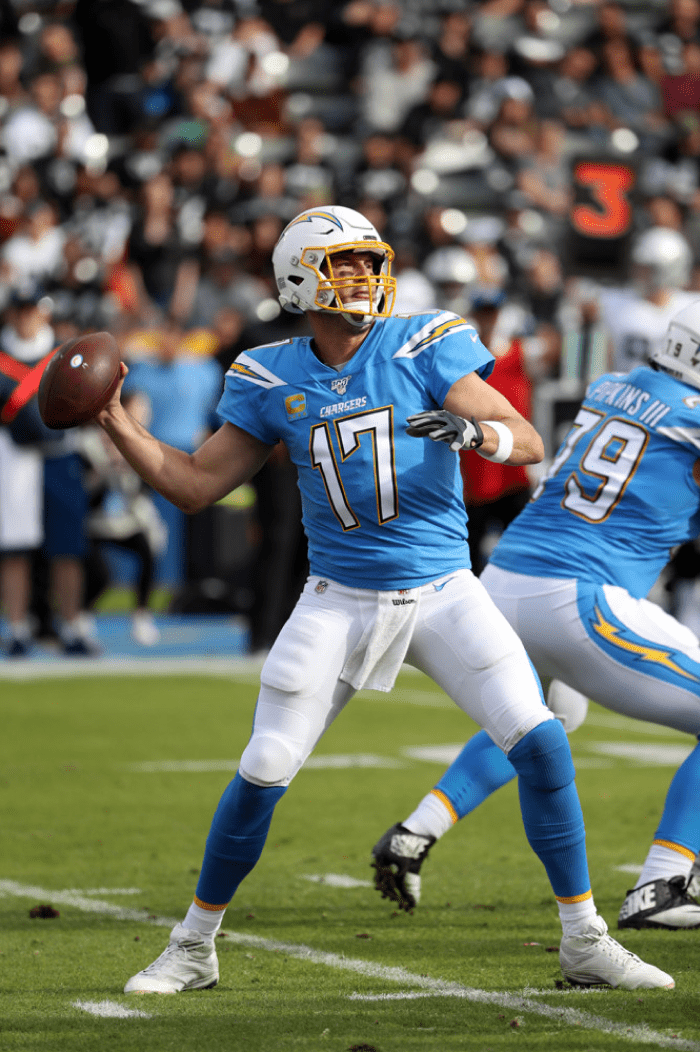
ONE
The Los Angeles Chargers were founded in 1959 by Barron Hilton, son of Hilton Hotels’ Conrad Hilton, and aimed to compete in the brand-new American Football League. Hilton ran a contest in order to find a name for his new AFL team, and eventually ‘Chargers’ was selected as the winner. The Chargers’ first season came in 1960, playing at the Los Angeles Coliseum - finishing the year 10-4 under offensive guru Sid Gillman, remembered as one of the greatest minds in the history of gridiron football. They reached the first-ever AFL Championship Game - but lost to the Houston Oilers.

Old Los Angeles Chargers Logo
TWO
Despite the Chargers’ rapid success on the field, Barron Hilton was dissatisfied with the lack of support for the team in Los Angeles. So in 1961, he made the decision to move the team to San Diego - spurred on by the San Diego Union newspaper’s sports editor, Jack Murphy. Moving into Balboa Stadium, which had its capacity increased to 34,000 for the 1961 season, the Chargers again reached the AFL Championship Game. However, facing the Houston Oilers once more, they fell just short of the title, losing 10-3. Lance Alworth, considered one of the greatest wide receivers in football history, was drafted by the Oakland Raiders in 1962 - who then traded him to San Diego. Alworth, nicknamed ‘Bambi’ due to his build and grace, was a vital member of the Chargers team that won the AFL Championship Game over the Boston Patriots, 51-10, in the 1963 season. After reaching the championship game in the following two seasons, Hilton sold the team to a group fronted by Eugene Klein in 1966. Four years later, the team joined the AFC as a part of the AFL/NFL merger, playing at San Diego Stadium.

Lance Alworth, Wide Receiver 1962-1970
THREE
The Chargers struggled initially in the NFL, and their fortunes didn’t change until Don Coryell was hired as head coach in 1978. Coryell’s new offense, nicknamed ‘Air Coryell’ due to its emphasis on deep, vertical passes, propelled the team into contention - whilst turning quarterback Dan Fouts, wide receiver Charlie Joiner, and tight end Kellen Winslow into eventual Hall of Famers. Despite their incredible firepower and regular season dominance, San Diego never reached the Super Bowl - losing the AFC Championship Game in both the 1980 and 1981 seasons.

Dan Fouts, Quarterback 1973-1987
FOUR
Starting in 1983, San Diego missed the playoffs for nine consecutive seasons. In 1984, Alex Spanos purchased 60% of the team from Eugene Klein and spent the next decade buying shares from minority owners - eventually owning 97% of the franchise. Coryell left the team partway through the 1986 season after a disappointing start, and by the 1988 season all the star players from the Air Coryell days - Dan Fouts, Charlie Joiner and Kellen Winslow - had retired. The Chargers’ revival came under head coach Bobby Ross and iconic linebacker Junior Seau in the 1992 season - reaching the playoffs despite winning none of their first four games.
FIVE
San Diego didn’t return to the playoffs straight away, but they did, however, manage to emulate their 11-5 record from 1992 in the 1994 season. Behind Junior Seau, defensive end Leslie O’Neal and running back Natrone Means, San Diego went on to defeat the Miami Dolphins in the Divisional Round and the Pittsburgh Steelers in the AFC Championship Game to reach the franchise’s first-ever Super Bowl. However, in Super Bowl XXIX against the San Francisco 49ers - led by quarterback Steve Young and wide receiver Jerry Rice - the Chargers were outmatched. Young set a Super Bowl record with six touchdown passes as San Francisco claimed a 49-26 victory.

Junior Seau, Linebacker 1990-2002
SIX
Bobby Ross departed after the 1996 season and the Chargers struggled once more - winning just four games in the 1997 season. In need of a quarterback, the team turned to the 1998 NFL Draft - trading numerous assets in exchange for the second overall selection. Luckily, the two players considered the best in the draft were quarterbacks - Peyton Manning and Ryan Leaf. Manning was selected first overall, so San Diego went with Leaf. The decision proved to be disastrous, as Leaf became one of the biggest draft busts in NFL history and was released after just three seasons due to a combination of character issues, injuries and poor play. Leaf’s final year saw the team win just one game, and earn the first overall pick in 2001.
SEVEN
San Diego made amends for the drafting of Ryan Leaf with the selections of running back LaDainian Tomlinson and quarterback Drew Brees in the 2001 NFL Draft - after trading away the first overall selection. Marty Schottenheimer was hired as head coach ahead of the 2002 season and in the 2004 NFL Draft they held the first overall pick. Unfortunately, quarterback Eli Manning refused to play for San Diego, even if they drafted him. So, the Chargers selected Manning and traded him for another quarterback, Philip Rivers. After Brees suffered a shoulder injury in the 2005 season, he signed for the New Orleans Saints in 2006 - allowing Rivers to finally step into the limelight. In the 2006 season, Tomlinson was named league MVP as he set an NFL record for touchdowns in a single season, with 31.

LaDainian Tomlinson, Running Back 2001-2009
EIGHT
2006 would be Marty Schottenheimer’s last season with the team and his replacement, Norv Turner, coached the Chargers to an AFC Championship Game appearance in the 2007 season - a game that Rivers played with a torn ACL. Tomlinson was released by San Diego in 2010 and Rivers, even with perennial Pro Bowl tight end Antonio Gates, could never lead the Chargers to a Super Bowl. Turner was fired after the 2012 season and the team made just one more playoff appearance before the franchise underwent yet another transformation.

Philip Rivers, Quarterback 2004-2019
NINE
In 2017, it was announced the Chargers would be returning to Los Angeles, playing at the StubHub Center until the state-of-the-art SoFi Stadium opened in 2020 - which they share with the Los Angeles Rams. Rivers left the team in 2020 as the franchise’s all-time passing leader. His replacement was found after a medical mishap thrust rookie Justin Herbert - the sixth overall pick in the 2020 NFL Draft - into the starting lineup. Herbert broke numerous rookie passing records that season and, in his second year, established himself as one of the league’s best quarterbacks. Herbert, and head coach Brandon Staley, led the Chargers back to the playoffs in the 2022 season, but despite a 27-0 lead over the Jacksonville Jaguars, lost in the Wild Card Round. Staley was replaced by Jim Harbaugh in the 2024 offseason looking to reignite the franchise and unlock the potential of the roster.

Justin Herbert, Quarterback 2020-Present
BEFORE YOU GO
One of the most memorable games in NFL history, known as the "Epic in Miami," took place during the 1981 AFC Divisional Playoff game between the Chargers and the Miami Dolphins. The Chargers won 41-38 in an overtime thriller, and Kellen Winslow's heroic performance, despite multiple injuries, became legendary.

The Chargers currently share SoFi Stadium in Inglewood, California, with the Los Angeles Rams. The stadium, which opened in 2020, is a state-of-the-art facility and one of the most expensive stadiums ever built.

According to Forbes, the Los Angeles Chargers net worth is estimated at $4.15 billion as of 2023.










